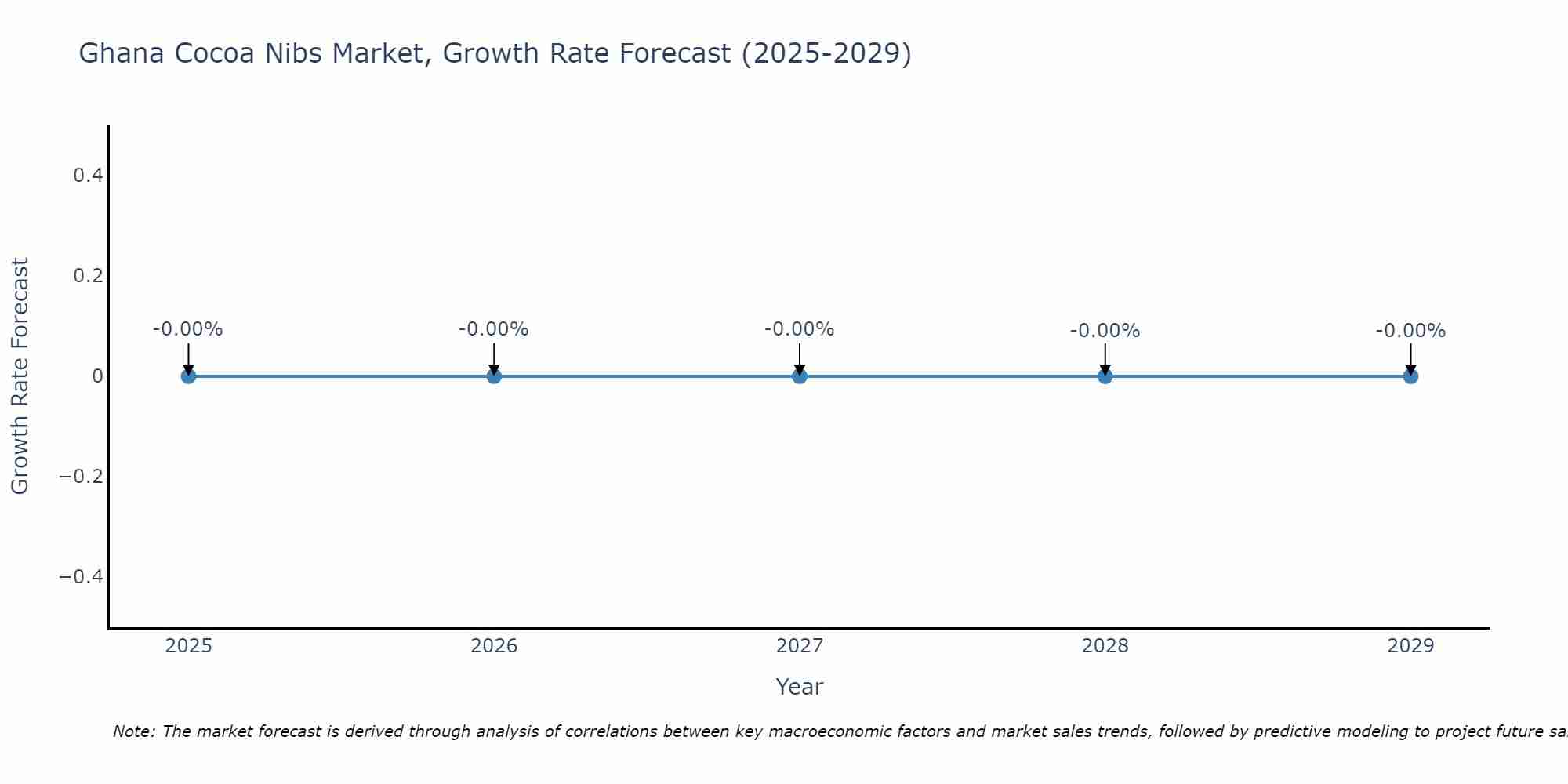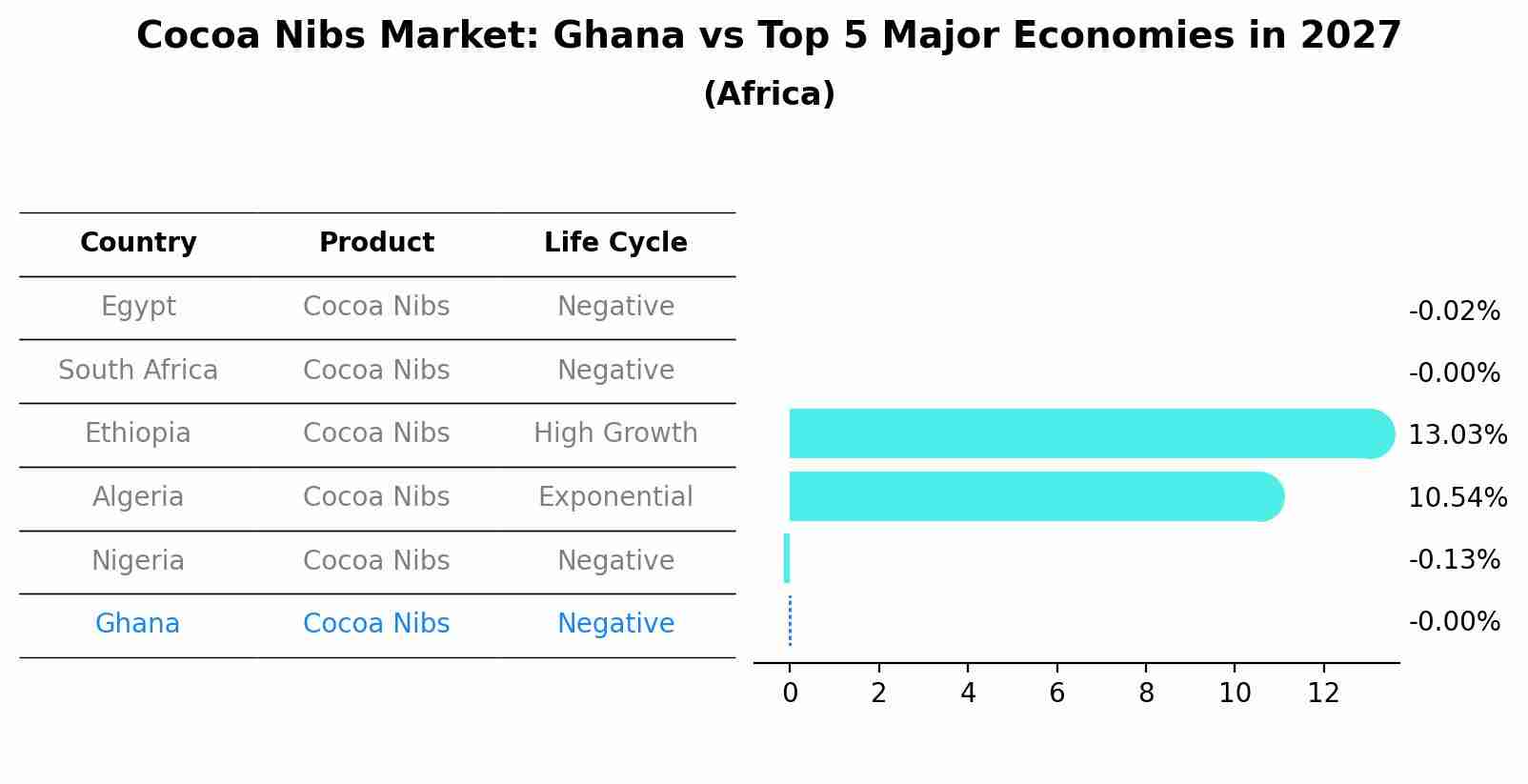Ghana Cocoa Nibs Market (2025-2031) Outlook | Forecast, Industry, Growth, Share, Size, Analysis, Companies, Revenue, Value & Trends
| Product Code: ETC107295 | Publication Date: Jun 2021 | Updated Date: Jun 2025 | Product Type: Report | |
| Publisher: 6Wresearch | Author: Ravi Bhandari | No. of Pages: 70 | No. of Figures: 35 | No. of Tables: 5 |
Ghana Cocoa Nibs Market Size Growth Rate
The Ghana Cocoa Nibs Market could see a tapering of growth rates over 2025 to 2029. Although the growth rate starts strong at -0.00% in 2025, it steadily loses momentum, ending at -0.00% by 2029.

Cocoa Nibs Market: Ghana vs Top 5 Major Economies in 2027 (Africa)
By 2027, Ghana's Cocoa Nibs market is forecasted to achieve a negative growth rate of -0.00%, with Egypt leading the Africa region, followed by South Africa, Ethiopia, Algeria and Nigeria.

Ghana Cocoa Nibs Market Overview
The Ghana Cocoa Nibs Market is a vital segment of the global cocoa products industry, with Ghana being one of the largest producers of cocoa beans globally. Cocoa nibs are the raw crushed pieces of cocoa beans and are known for their rich chocolate flavor and nutritional benefits. The market for cocoa nibs in Ghana is driven by increasing consumer demand for natural and organic food products, as well as the rising popularity of dark chocolate and healthy snacks. Ghana`s reputation for producing high-quality cocoa beans further enhances the market for cocoa nibs, attracting both domestic and international buyers. With the country`s focus on sustainable cocoa farming practices and quality control measures, the Ghana Cocoa Nibs Market is poised for continued growth and expansion in the coming years.
Ghana Cocoa Nibs Market Trends
The Ghana Cocoa Nibs market is experiencing a growing demand for organic and fair trade cocoa nibs due to increasing consumer awareness of sustainability and ethical sourcing practices. There is also a rising interest in premium quality cocoa nibs with unique flavor profiles, driving producers to focus on enhancing the quality and distinctiveness of their products. Health-conscious consumers are seeking out cocoa nibs for their nutritional benefits, such as being a rich source of antioxidants and minerals. Additionally, the trend of incorporating cocoa nibs into a variety of food and beverage products, such as snacks, desserts, and beverages, is expanding the market opportunities for manufacturers and retailers in Ghana. Overall, the Ghana Cocoa Nibs market is seeing a shift towards higher quality, ethically sourced products that cater to health-conscious and discerning consumers.
Ghana Cocoa Nibs Market Challenges
In the Ghana Cocoa Nibs Market, there are several challenges that stakeholders face. One key challenge is maintaining consistent quality standards due to factors like weather fluctuations and pests that can impact cocoa bean production. Additionally, the lack of modern processing facilities and infrastructure in some regions can hinder the efficient processing and distribution of cocoa nibs. Limited access to financing and technology for small-scale farmers also poses a challenge in improving productivity and meeting market demand. Furthermore, fluctuating global cocoa prices and competition from other cocoa-producing countries add complexity to the market dynamics. Overall, addressing these challenges will be crucial for the sustainable growth and competitiveness of the Ghana Cocoa Nibs Market.
Ghana Cocoa Nibs Market Investment Opportunities
The Ghana Cocoa Nibs Market presents promising investment opportunities due to the increasing global demand for high-quality cocoa products. With Ghana being one of the world`s largest producers of cocoa beans, investing in the cocoa nibs market can be lucrative. Cocoa nibs are gaining popularity as a healthy and flavorful ingredient in the food and beverage industry, especially in the premium chocolate sector. Investors can consider opportunities in cocoa processing facilities, value-added product development, and export of cocoa nibs to international markets. Additionally, investing in sustainable and ethically sourced cocoa production practices can further enhance the market potential and attract socially conscious consumers. Overall, the Ghana Cocoa Nibs Market offers a diverse range of investment avenues with the potential for long-term growth and profitability.
Ghana Cocoa Nibs Market Government Policy
The Ghanaian government has implemented various policies to support and regulate the cocoa nibs market. These policies include the Cocoa Marketing Company (CMC) being the sole purchaser of cocoa beans and regulating the export of cocoa products to ensure fair prices for farmers. Additionally, the government established the Cocoa Board to oversee the sector, with initiatives such as the Productivity Enhancement Program (PEP) aimed at increasing yields and quality. The Cocoa Disease and Pest Control Program (CODAPEC) also provides support to farmers to combat diseases and pests. Overall, these policies aim to promote sustainable cocoa production, support farmers, and maintain Ghana`s position as a leading cocoa producer in the global market.
Ghana Cocoa Nibs Market Future Outlook
The future outlook for the Ghana Cocoa Nibs Market appears promising, driven by increasing consumer awareness of the health benefits of cocoa products and the rising demand for natural and organic ingredients in the food and beverage industry. As Ghana is one of the world`s largest producers of cocoa beans, there is a strong foundation for the growth of the cocoa nibs market in the country. Additionally, the growing trend of premiumization and the popularity of dark chocolate among consumers are expected to further boost the demand for cocoa nibs. With the government`s support for the cocoa industry and efforts to improve quality and sustainability practices, Ghana is well-positioned to capitalize on the expanding global market for cocoa nibs.
Key Highlights of the Report:
- Ghana Cocoa Nibs Market Outlook
- Market Size of Ghana Cocoa Nibs Market, 2021
- Forecast of Ghana Cocoa Nibs Market, 2031
- Historical Data and Forecast of Ghana Cocoa Nibs Revenues & Volume for the Period 2021 - 2031
- Ghana Cocoa Nibs Market Trend Evolution
- Ghana Cocoa Nibs Market Drivers and Challenges
- Ghana Cocoa Nibs Price Trends
- Ghana Cocoa Nibs Porter's Five Forces
- Ghana Cocoa Nibs Industry Life Cycle
- Historical Data and Forecast of Ghana Cocoa Nibs Market Revenues & Volume By Product for the Period 2021 - 2031
- Historical Data and Forecast of Ghana Cocoa Nibs Market Revenues & Volume By Conventional for the Period 2021 - 2031
- Historical Data and Forecast of Ghana Cocoa Nibs Market Revenues & Volume By Organic for the Period 2021 - 2031
- Historical Data and Forecast of Ghana Cocoa Nibs Market Revenues & Volume By Application for the Period 2021 - 2031
- Historical Data and Forecast of Ghana Cocoa Nibs Market Revenues & Volume By Commercial for the Period 2021 - 2031
- Historical Data and Forecast of Ghana Cocoa Nibs Market Revenues & Volume By Household for the Period 2021 - 2031
- Ghana Cocoa Nibs Import Export Trade Statistics
- Market Opportunity Assessment By Product
- Market Opportunity Assessment By Application
- Ghana Cocoa Nibs Top Companies Market Share
- Ghana Cocoa Nibs Competitive Benchmarking By Technical and Operational Parameters
- Ghana Cocoa Nibs Company Profiles
- Ghana Cocoa Nibs Key Strategic Recommendations
Frequently Asked Questions About the Market Study (FAQs):
1 Executive Summary |
2 Introduction |
2.1 Key Highlights of the Report |
2.2 Report Description |
2.3 Market Scope & Segmentation |
2.4 Research Methodology |
2.5 Assumptions |
3 Ghana Cocoa Nibs Market Overview |
3.1 Ghana Country Macro Economic Indicators |
3.2 Ghana Cocoa Nibs Market Revenues & Volume, 2021 & 2031F |
3.3 Ghana Cocoa Nibs Market - Industry Life Cycle |
3.4 Ghana Cocoa Nibs Market - Porter's Five Forces |
3.5 Ghana Cocoa Nibs Market Revenues & Volume Share, By Form, 2021 & 2031F |
3.6 Ghana Cocoa Nibs Market Revenues & Volume Share, By Form, 2021 & 2031F |
4 Ghana Cocoa Nibs Market Dynamics |
4.1 Impact Analysis |
4.2 Market Drivers |
4.3 Market Restraints |
5 Ghana Cocoa Nibs Market Trends |
6 Ghana Cocoa Nibs Market, By Types |
6.1 Ghana Cocoa Nibs Market, By Product |
6.1.1 Overview and Analysis |
6.1.2 Ghana Cocoa Nibs Market Revenues & Volume, By Product, 2018 - 2027F |
6.1.3 Ghana Cocoa Nibs Market Revenues & Volume, By Conventional, 2018 - 2027F |
6.1.4 Ghana Cocoa Nibs Market Revenues & Volume, By Organic, 2018 - 2027F |
6.2 Ghana Cocoa Nibs Market, By Application |
6.2.1 Overview and Analysis |
6.2.2 Ghana Cocoa Nibs Market Revenues & Volume, By Commercial, 2018 - 2027F |
6.2.3 Ghana Cocoa Nibs Market Revenues & Volume, By Household, 2018 - 2027F |
7 Ghana Cocoa Nibs Market Import-Export Trade Statistics |
7.1 Ghana Cocoa Nibs Market Export to Major Countries |
7.2 Ghana Cocoa Nibs Market Imports from Major Countries |
8 Ghana Cocoa Nibs Market Key Performance Indicators |
9 Ghana Cocoa Nibs Market - Opportunity Assessment |
9.1 Ghana Cocoa Nibs Market Opportunity Assessment, By Product, 2021 & 2031F |
9.2 Ghana Cocoa Nibs Market Opportunity Assessment, By Application, 2021 & 2031F |
10 Ghana Cocoa Nibs Market - Competitive Landscape |
10.1 Ghana Cocoa Nibs Market Revenue Share, By Companies, 2021 |
10.2 Ghana Cocoa Nibs Market Competitive Benchmarking, By Operating and Technical Parameters |
11 Company Profiles |
12 Recommendations |
13 Disclaimer |
- Single User License$ 1,995
- Department License$ 2,400
- Site License$ 3,120
- Global License$ 3,795
Search
Thought Leadership and Analyst Meet
Our Clients
Related Reports
- Canada Oil and Gas Market (2026-2032) | Share, Segmentation, Value, Industry, Trends, Forecast, Analysis, Size & Revenue, Growth, Competitive Landscape, Outlook, Companies
- Germany Breakfast Food Market (2026-2032) | Industry, Share, Growth, Size, Companies, Value, Analysis, Revenue, Trends, Forecast & Outlook
- Australia Briquette Market (2025-2031) | Growth, Size, Revenue, Forecast, Analysis, Trends, Value, Share, Industry & Companies
- Vietnam System Integrator Market (2025-2031) | Size, Companies, Analysis, Industry, Value, Forecast, Growth, Trends, Revenue & Share
- ASEAN and Thailand Brain Health Supplements Market (2025-2031) | Strategy, Consumer Insights, Analysis, Investment Trends, Opportunities, Growth, Size, Share, Industry, Revenue, Segments, Value, Segmentation, Supply, Forecast, Restraints, Outlook, Competition, Drivers, Trends, Demand, Pricing Analysis, Competitive, Strategic Insights, Companies, Challenges
- ASEAN Bearings Market (2025-2031) | Strategy, Consumer Insights, Analysis, Investment Trends, Opportunities, Growth, Size, Share, Industry, Revenue, Segments, Value, Segmentation, Supply, Forecast, Restraints, Outlook, Competition, Drivers, Trends, Demand, Pricing Analysis, Competitive, Strategic Insights, Companies, Challenges
- Europe Flooring Market (2025-2031) | Outlook, Share, Industry, Trends, Forecast, Companies, Revenue, Size, Analysis, Growth & Value
- Saudi Arabia Manlift Market (2025-2031) | Outlook, Size, Growth, Trends, Companies, Industry, Revenue, Value, Share, Forecast & Analysis
- Uganda Excavator, Crane, and Wheel Loaders Market (2025-2031) | Strategy, Consumer Insights, Analysis, Investment Trends, Opportunities, Growth, Size, Share, Industry, Revenue, Segments, Value, Segmentation, Supply, Forecast, Restraints, Outlook, Competition, Drivers, Trends, Demand, Pricing Analysis, Competitive, Strategic Insights, Companies, Challenges
- Rwanda Excavator, Crane, and Wheel Loaders Market (2025-2031) | Strategy, Consumer Insights, Analysis, Investment Trends, Opportunities, Growth, Size, Share, Industry, Revenue, Segments, Value, Segmentation, Supply, Forecast, Restraints, Outlook, Competition, Drivers, Trends, Demand, Pricing Analysis, Competitive, Strategic Insights, Companies, Challenges
Industry Events and Analyst Meet
Whitepaper
- Middle East & Africa Commercial Security Market Click here to view more.
- Middle East & Africa Fire Safety Systems & Equipment Market Click here to view more.
- GCC Drone Market Click here to view more.
- Middle East Lighting Fixture Market Click here to view more.
- GCC Physical & Perimeter Security Market Click here to view more.
6WResearch In News
- Doha a strategic location for EV manufacturing hub: IPA Qatar
- Demand for luxury TVs surging in the GCC, says Samsung
- Empowering Growth: The Thriving Journey of Bangladesh’s Cable Industry
- Demand for luxury TVs surging in the GCC, says Samsung
- Video call with a traditional healer? Once unthinkable, it’s now common in South Africa
- Intelligent Buildings To Smooth GCC’s Path To Net Zero


















